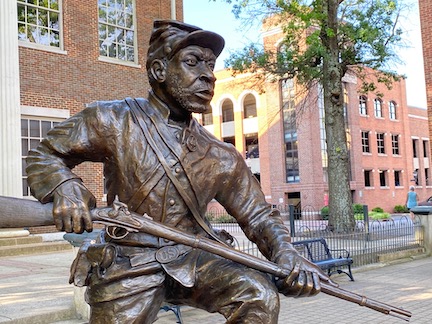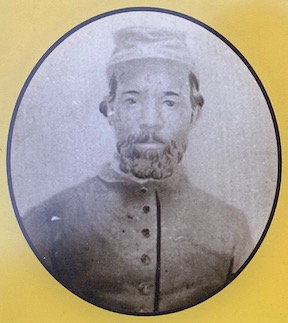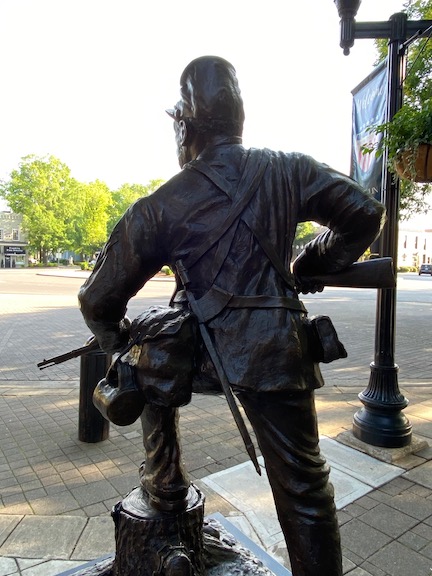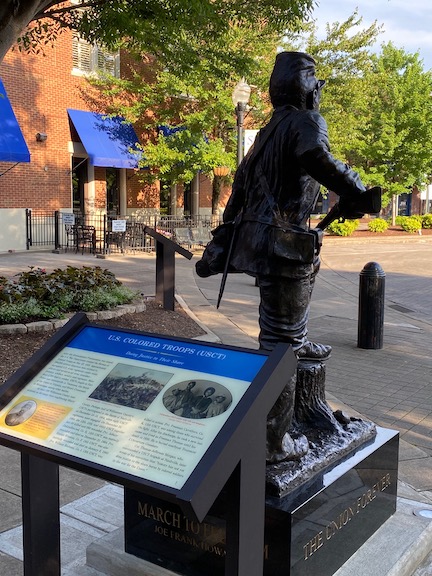“Doing Justice to Their Share”
 “[H]istory has not yet done justice to the share borne by colored soldiers in the war for the Union,” wrote Col. Thomas Jefferson Morgan, commander of a USCT brigade at the battle of Nashville.
“[H]istory has not yet done justice to the share borne by colored soldiers in the war for the Union,” wrote Col. Thomas Jefferson Morgan, commander of a USCT brigade at the battle of Nashville.
A statue installed in the town square in Franklin, Tennessee, last October has begun to correct that story. The statue, sculpted by Tennessee native Joe F. Howard and displayed on a base created by Vincent Baker, honors the United States Colored Troops. Fundraisers collected $150,000 to fund the statue, which was dedicated to much fanfare last fall. I had the opportunity this week to see it for myself for the first time.
Williamson County, Tennessee, where Franklin is located, furnished at least 300 men to the USCT, many of whom participated in the December 1864 battle of Nashville. A sign installed near the monument lists the fate of several of those men.

One soldier receiving special attention was Pvt. James Moore was in the 111th USCT, whom the figure in the statue seems loosely based on and whose story is featured on the sign. Captured by Nathan Bedford Forrest’s cavalry at Sulphur Trestle, Alabama, Moore and other members of his regiment were returned to slavery and forced to work on the fortifications around Mobile Bay. Federal troops rescued him in May 1865. After the war, Moore settled in Williamson County.
The statue’s installation was part of an initiative called “The Fuller Story,” a city-wide project in Franklin that sprang from the wake of the 2017 events in Charlottesville, Virginia. The Fuller Story aimed “to provide proactive solutions on the national controversy surrounding Confederate monuments,” says the Battle of Franklin Trust website, with a focus “on what could be put up as opposed to what could be taken down.” Local churches led the way for the community dialogue that followed. For a fuller story on The Fuller Story, click here.
The Franklin town square is dominated by a Confederate memorial at the center of a traffic circle—a scene not uncommon in a lot of small towns. Cannons are posted on each of the four corners, facing outward. It’s a space fraught with meaning. According to a newspaper story that covered the unveiling, “The square is where enslaved people were sold and was the site of lynchings.” That made the square an uncomfortable place for some black residents. The statue’s presence seeks to help reclaim and redefine that space.
The statue stands on the northwest sidewalk on the outside of the traffic circle. It faces toward but not directly at the Confederate monument. The base of the statue says “Freedom. Liberty. Equality.”
In addition, the city and The Fuller Story have worked to provide context and interpretation for the overall space. Several wayside signs, like the one next to the USCT statue, are scattered throughout the square in an effort to contextualize.
I particularly liked the fact that the statue was at street level, not on a pedestal or plimf. That allowed me to look closely. I felt like I was engaging, not just staring up as something, which helped me appreciate it all the more.
For those who’ve not yet had the opportunity to see the statue for themselves, I’m pleased to offer a few additional photos for you:
Click here for more on Baker’s work creating the base.
Click here for more on the statue’s inscription.
Click here for more on the Battle of Franklin Trust.







Certainly a much better statue than the one that was inflicted on MLK, Jr in Washington, D.C. The Confederate Memorial is apparently involved in litigation.
Thank you for this story and pictures. I’m glad that Franklin erected this statue and I hope other communities follow suit. For example, there should be a statue to the African-American soldiers who were awarded the medal of honor for storming New Market Heights outside of Richmond. As quoted in the story, this is an example of building up rather than tearing down.
A monument honoring the USCTs who fought at New Market Heights is in the works. Learn more and support the efforts of the Battle of New Market Heights Memorial and Education Association at: https://battleofnewmarketheights.org/
It is a shameful part of our past to realize that many, if not the majority of the USCT, were forced to serve in the Union Army according to a recent study. Impressment involved all kinds of unethical means including murder! But that has long been suppressed and sugar-coated.
And had Lincoln lived to work out his plan of colonization of ALL blacks to any godforsaken place but here, that “Freedom, Liberty, Equality” mentioned would have been on foreign soil. Lincoln was quite clear that in his racist mind, political rights trumped natural rights:
“Negroes have Natural Rights, although they cannot enjoy them here, and even Taney once said that ‘though it does not declare that all men are equal in their attainments and social position, yet no sane man will attempt to deny that the African upon his own soil has all the rights that instrument vouchsafes to all mankind.’”
In other words, his political will to rid the country of blacks would override the natural rights of blacks in America. Rights Lincoln said blacks were forever forbidden to exercise here:
There is a physical difference between the white and black races, which I believe, will forever forbid the two races from living together on terms of social and political equality. And I as much as any other man am in favor of having the superior position assigned to the white race.”
Fortunately for black people, Lincoln did not live to execute his colonization plan, the logistics of which he was still working on until the week he died.
Also fortunate for black people was the Republican Party’s realization that blacks could be exploited for purposes of political power in the South. But then, when Republicans realized blacks were no longer needed to maintain Republican control of the Federal government, they turned all that “egalitarian” ambition on the Plains Indians!
Using a post about giving the USCTs their due to claim they weren’t willing soldiers in a fight for their own freedom and to spout racist claptrap. Classy, real classy.
Thanks for helping to bring attention to Franklin and Williamson County’s USCT veterans. You might also find my website http://www.SlavesToSoldiers.org to be of interest. Since 2016, I have been identifying, researching and telling the stories of Williamson County’s Black USCT and US Navy Civil War veterans. The #SlavesToSoldiers project raises funds to install individual brick pavers inscribed with their names in Franklin’s Veterans Park – two blocks from the statue. On my website you can learn the individual stories of the men behind the statue. Our hope is that they will never be forgotten.
The Fiery Trail by Eric Foner stated the Lincoln had given up the idea of colonization despite several attempts. The XIII Amendment did not tie colonization to emancipation.
I love the added detail of the shackles. So much meaning. Thank you for sharing!